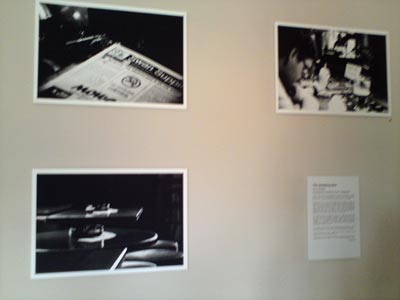This is a post mainly about playlists associated with novels but also has a few references to the BBC3 TV programme Lip Service, which ended its first series last night. Having had a look at a few website analytics I have to start with an apology to the people who’ve ended up on this blog after doing a Google search for Lip Service’s Ruta Gedmintas (or in one case Ruta Gedmintas’s feet!). I think there’s only one blog post about her — in the context that her very effective playing of Frankie in the series eerily summed up the zeitgeist of one of my novel-in-progress’s characters). Nevertheless, for some odd reason this site seems to occasionally turn up in Google searches associated with the actress. This might get worse as I’m going to mention her again in this post.
So if you’ve landed on this page looking for some nice photos of Ruta Gedmintas then the best I can do is provide a consolation link to a photo on the programme’s official Facebook page that captures a beguiling, almost feral look to Frankie — click here to see it (you don’t need to be signed into Facebook to see it). (There will be also be another Frankie related link later on.)
I mentioned David Nicholls’ use of playlists in the last post. In ‘One Day’ Emma makes Dexter a couple of laboriously compiled cassette tapes — from tape-recording on to a cassette tracks from vinyl records and CDs in real time as you had to from the mid-70s until the era of the MP3. Even though CD-ROM drives came along in the mid-90s, it was a bit later than that that the likes of iTunes and Windows Media Player allowed instant playlists to be compiled and burnt to CD — and later digitally — and now we have semi-predictive services like Spotify which make the whole process almost subconsciously easy. My computer made up a playlist last night (presumably from tracks I’d played a lot or hadn’t skipped and it kept me awake an extra hour as I didn’t want to stop the fantastic tracks from coming.
What playlists — and the ‘my music’ concept as a whole — seem to tap into is a deep-seated desire to identify oneself with your favourite music — almost as if that might partially define your personality. Music is often used in TV and film in a similar way and Lip Service has been a good example — the track listing of music from each episode has been demanded by fans and published online.
I’m also very fond of thinking about music in relation to the parts of the novel that I’m writing and I’ve got a habit of describing the music characters are listening to — James likes ‘talented, blonde singer-songwriters like Pixie Lott’ and Dido, Emma likes William Orbit and Kim is a bit eclectic, enjoying a bit of John Tavener or Thomas Tallis as well as Gabriela Cilme (‘Sweet About Me’) and the Walrus of Love, Barry White plus another significant act to be revealed anon.
Referencing music is great but one thing I’ve learned about novel writing — Penny Rudge mentioned this when she talked to our City class — is that quoting lyrics is done at a cost — a pretty high monetary one. Even a line or two needs permission (unlike, perhaps, a quotation from a longer written work) and that might cost into the hundreds of pounds — and the author usually pays the rights holder. So it’s a lot more cost-effective to cite the title and artist and hope the readers can fill in the lyrics for themselves (if that’s really necessary) as there’s no copyright on titles and names. It could be argued that playlists like those created by David Nicholls and Lip Service are actually intellectual property in themselves — I seem to remember a court case in the distant past about this connected with Classic FM first starting up.
As The Angel is set largely in a pub, I was speculating last night listening to my auto-generated list that it would be almost inevitable that there would sadly be some riotous party for me to test my writing skills on and, as part of that, I wondered about taking a page or two just to list the music — as other writers tend to throw in odd bits of ephemera like shopping lists or envelopes.
And then in a moment of pure serendipity, I noticed a tweet from Kudos TV’s head Lip Servant on the very subject of playlists. (I’ve exchanged a few tweets with @LipService_BBC3, most recently today when I forwarded a link to the Arts Desk review of the last episode, which has a comment from me added. She’s also read the existing posting on this blog.) This tweet revealed that Ruta Gedmintas had been persuaded to publish her Frankie playlist — songs on her iPod that she used to work herself up into the right mood for the character — so the concept of establishing character via music choices obviously works for her.
It’s on the Notes page of the programme’s Facebook site but can (I think) be accessed without needing to be signed in. Click here to read it:Â http://on.fb.me/9q7qOV .
There’s even a link there to hear them all on Spotify, which I might have a go at doing out of curiosity as I’ve never heard of most of them. I do, though, have the Florence and the Machine and Bat for Lashes albums so I probably know them. It’s not too surprising to see Björk and the Prodigy there given the character she was playing. However, for me, the serendipitous part was finding the title of a track listed in the playlist that I’d written as the closing line of the novel extract that I workshopped 10 days ago (and wrote about three weeks ago) which a few people who read it said was perfect for the scene I’d written — and I can see why it’s also completely apt for Frankie. I’d probably watched a couple of episodes of Lip Service before I decided on this song but her playlist wasn’t published until this week. Here’s how I referenced it in my writing:
‘Her hand reached into his lap and grabbed the entertainment system’s remote control from where it had dropped…She entered the title of a song that seemed perfect for the pair of them. The screen displayed a list of versions she never dreamt existed but she chose Nouvelle Vague’s cabaret cover over the Dead Kennedy’s original. As she sipped her drink, the suite infused with the sophisticated sound of brushes against drum skins and the ironic twang of the double-bass. Then a cool French chanteuse started to croon “Too Drunk To Fuck”.’






